Excerpts from Jim Conrad's
Naturalist Newsletter
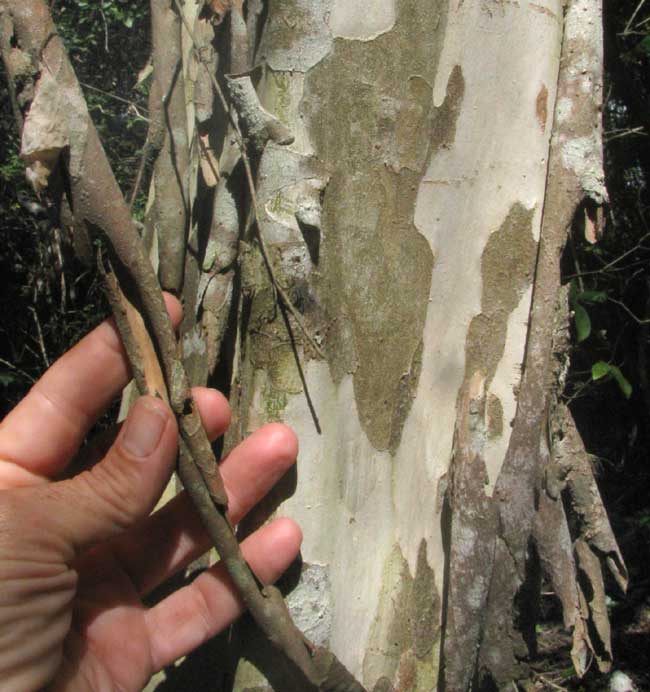
from the December 18, 2011 Newsletter issued from Hacienda Chichen Resort beside Chichén Itzá Ruins; limestone bedrock; elevation ~39m (~128ft), N20.675°, W88.569°; central Yucatán state, MÉXICO
WHITESEED MANGA'S PATCHY, FLAKING BARK
In the Yucatán the farther northwest you go the more arid it becomes, the lower and more scrubby the vegetation is, and the more species of feathery-leafed trees belonging to the Bean Family you find. Newcomers are overwhelmed trying to sort out all the acacia-like trees. One of those trees is easy to distinguish, though, merely from its bark and leaves. Basically, it's the one with frilly, acacia-like leaves but a patchy, scaly, sycamore-like trunk. You can see a typically mottled, very actively flaking-off trunk above. Often around the base of such trees the ground will be completely covered with dry, curled-up flakes shed from the trunk. Now look at its twice-compound leaf below:
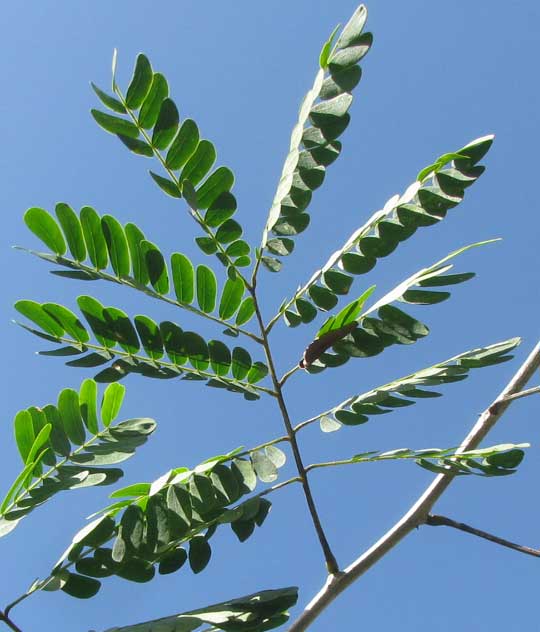
The whole picture shows just one "bipinnate," or twice divided, leaf with half-inch-long leaflets (12mm). The blade atop the petiole is divided into six primary divisions, and each primary division is subdivided into ten or so leaflets arising opposite one another.
This interesting tree, common here, especially where limestone bedrock juts from the soil, is a member of the Bean Family like the acacia, as well as a member of the Mimosa Subfamily, also like the acacia, but it belongs to a genus I'd never heard of before arriving here. It's CHLOROLEUCON MANGENSE, and there's not much about it on the Internet. My impression is that it's endemic just to the Yucatán.
from the May 31, 2015 Newsletter issued from Río Lagartos, on the Yucatan Peninsula's northern coast (~N21.60°, ~W88.16°), Yucatán state, MÉXICO
WHITESEED MANGA FLOWERING
Though most afternoons around five o'clock the sky toward the south darkens and it's clearly raining there, so far here in Río Lagartos we haven't had a single rain this month. The landscape is crispy-dry. Still, in the scrubby thorn forest south of town several woody species now are flowering and sometimes even leafing out, apparently in anticipation of eventual rains. You wonder just how they do it.
One such tree caught my eye this week because it was clearly an acacia or something close to it whose powder-puff-like flower clusters were different from any I'd noticed before. New leaves and stems were emerging along with the flowers. The tree's slender branches grew intermingled with neighboring trees and shrubs, so a portrait of it would just show a jumble but, below, you can see one of its flowering and leafing-out branches, its smallish flowering head fuzzy with long stamen filaments and perched atop a long stem, or peduncle:
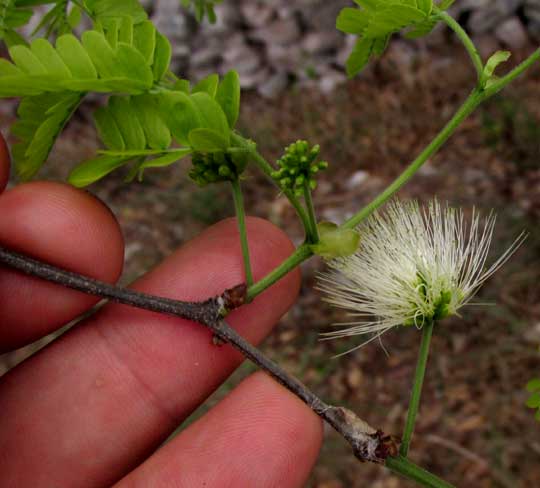
The flowering head is very much like an Acacia or Albizia, and its emerging leaves were twice-compound, also like species in those genera, as shown below:
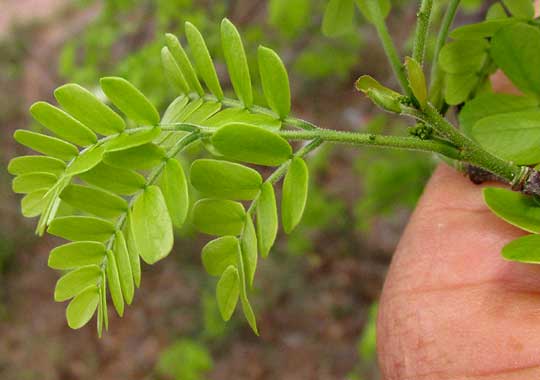
Also its legume-type fruits were typical of those species, as shown below:
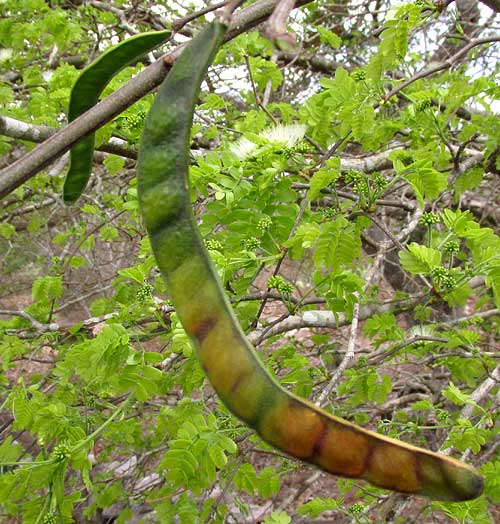
I'd about convinced myself that this was an Acacia or Albizia species when I noticed that the tree's trunk was smooth and blotchy, with peeling-off, curling flakes of bark, which wasn't like those species in those genera at all, as shown below:
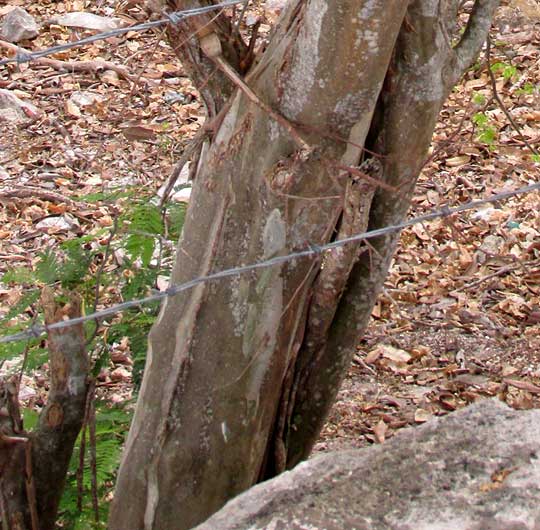
This kind of trunk I'd seen before, in the woods around Chichén Itzá ruins south of here. Back then I'd found that the trunk had been so distinctive that just it and its twice-pinnate leaves had enabled me to identify it as an Albizia close relative, CHLOROLEUCON MANGENSE. It's a widely distributed but often overlooked species occurring in dryish forests throughout most of Mexico south through Central America into the northern half of South America. An English name sometimes used for it is Whiteseed Manga. Here the Maya call it Yax-ek.
The Maya recognize Whiteseed Manga as a general source of wood, as producing young leaves and stems that livestock can browse, and as a good source of nectar for honeybees.
issued February 27, 2020 from the forest just west of Tepakán; elev. ~9m (~30 ft), N21.053°, W89.052°; north-central Yucatán state, MÉXICO
WHITESEED MANGA'S WHITE SEEDS
The rancho's Whiteseed Mangas are heavy with legumes, as seen below:
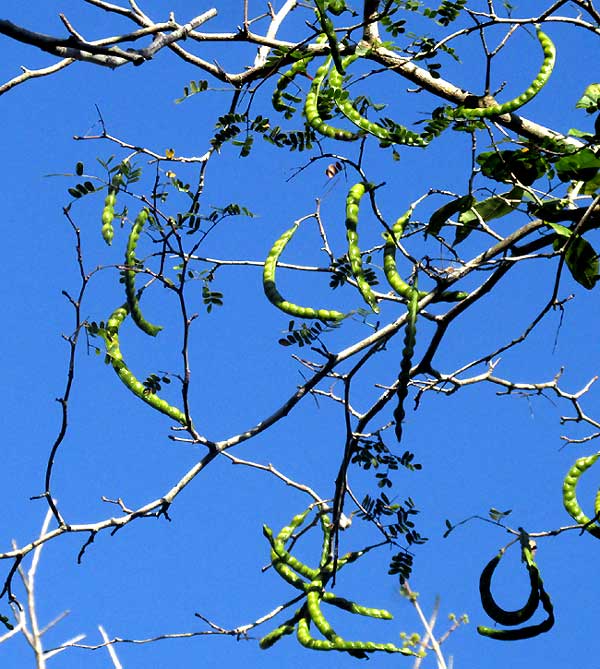
Previously I'd not confirmed for myself that the Whiteseed Manga really has white seeds. Here the trees' legumes are still a little green, but I found one on the ground more mature than the others, broke it open, and saw what's seen below:
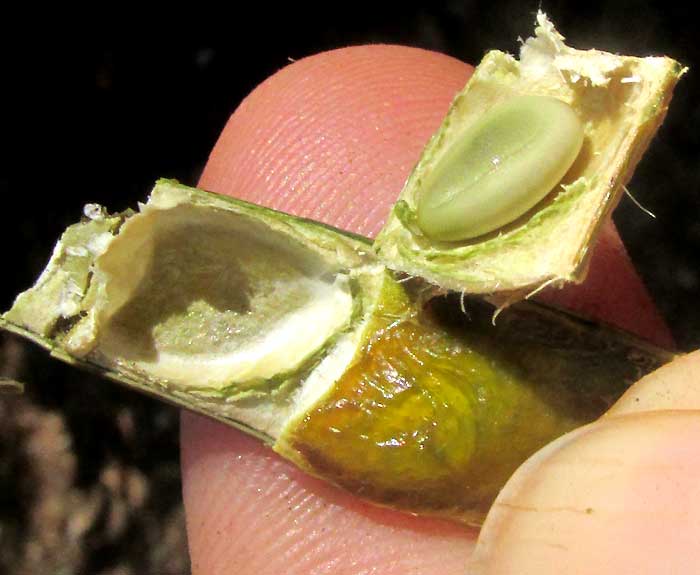
So the seeds really are white. Moreover, the exercise showed me that the legume shells are very tough, almost woody, but also each legume section containing a bean relatively easily separates from adjacent sections, so each compartment can be called a "loment."
from the May 10, 2018 Newsletter issued from Rancho Regensis north of Valladolid, Yucatán, MÉXICO;
elevation ~40m (~130 ft), N~20.876°, W~88.170°
WHITESEED MANGA'S YELLOWING FLOWER HEADS
A Whiteseed Manga, one of which roots on the opposite side of the deep pit extending to beneath the hut's porch. It reaches for sunlight with branches that cross the pit and almost touch the hut's thatch roof. Therefore, it was hard to miss the fact that this week the tree reached its peak in flowering. Below, you can see a skipper taking nectar from one of its hundreds of flower clusters
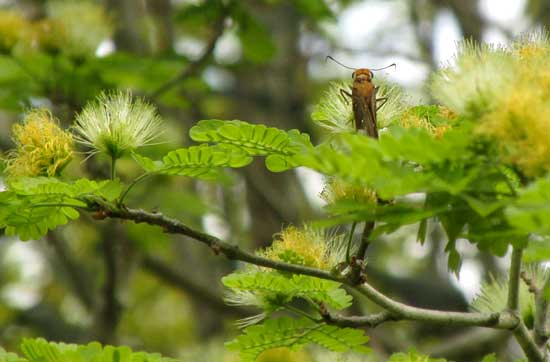
In that picture notice that certain of the clusters are white -- the whiteness contributed by stamen filaments radiating from individual flowers in the cluster -- while others are yellowish. The yellowness appears when white stamen filaments wilt and turn yellow. The white clusters remain white only during the morning of the first day the cluster opens; in afternoons and for several subsequent days, until the flowers fall away, the clusters are yellow. A close-up showing a white flower cluster with fresh stamen filaments beside a yellow one with drooping filaments, is shown below:
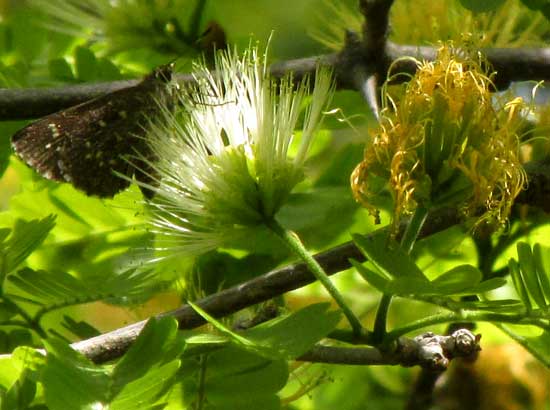
In both of the above pictures, skippers are taking nectar from white clusters, not the older yellow ones. Having watched the flowers for several hours, I've not seen a single butterfly or bee land on a yellowed cluster.
This is the tree's way of signaling to its pollinators that their time would be better spent visiting younger flowers, which are white. I've read that to insect eyes yellow flowers are much less visible than white ones, so it all makes sense.
I read that Whiteseed Mangas are highly regarded by beekeepers for their nectar production. That information is hard to reconcile with my having seen much fewer pollinators visiting flower clusters on several trees than seemed normal. For ten minutes during one recent morning just when I thought pollinators would be busiest, I stood beside a Whiteseed Manga in the clearing below the hut, and saw not a single butterfly or bee, not even a small, native bee, visiting any cluster.